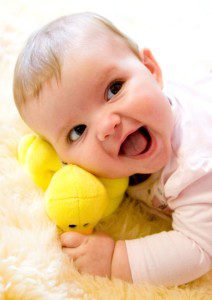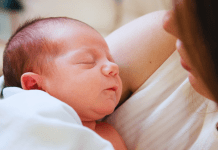This post is sponsored by Baby Sensory Development Classes. We partnered with Baby Sensory to bring Scottsdale Moms Blog readers a unique playgroup experience this past July. For more on infant development classes from Baby Sensory, visit their website.

The Sensory Baby
by Dr. Lin Day
The next time you read a book, stop for a moment and marvel at the amazing capacity of the brain to carry out such an intricate task. Processing information and co-ordinating the eyes involves many complex interactions between the brain and senses. Sensations from the outside world are changed into electrical impulses and carried to the brain, which then decodes the information to produce the image that is seen. Although the process of gathering and deciphering information begins before birth, as soon as the baby leaves the womb, the sense organs work overtime. This is the beginning of sensory education.
This article summarizes some of the most important findings about the development of the baby’s senses in the first year and suggests ways of leading learning forwards.
Sensory development
The learning ability of a baby in the first year of life is phenomenal. Throughout the first year, the baby’s brain goes through a process of development and specialisation unlike any other time in life. The potential for learning lies in providing conditions which enable the baby to develop fully, being aware of the different stages of development that babies pass through, observing them to find out how to build on their experiences and experimenting with different textures, sights, sounds, smells and tastes. In so doing, babies are given the best possible opportunity to learn about the world while they are still sensitive and absorbent. The good news is that sensory experiences can accelerate not only the learning of babies, but also the learning of children with learning difficulties.
Sensory experiences from birth
In recent years, much publicity has been given to the French physician, Frederick Leboyer, who was responsible for creating awareness of the functioning senses of the newborn in maternity wards. Leboyer’s revolutionary book ‘Birth without Violence’ inspired mothers all over the world to give birth in an environment that mirrored the baby’s prenatal surroundings. His work closely followed the work of Maria Montessori, who believed that experiences in early infancy had far-reaching implications for improving the quality of human life intellectually, physically and emotionally. Montessori realised that babies were far from passive in their learning and that they had an immense desire to explore the environment by means of their senses.
The sense of touch
Transition from the womb to warm water, approximate in temperature to the amniotic fluid, gives the baby the opportunity of making a gradual adjustment to the environment. Soft lighting and soothing music ensure that the first sensory experiences are as tranquil as possible. After this, contact may be with the mother who reassures the baby that the world is a warm and comforting place to be. Research increasingly supports the fact that touching the skin heightens sensory awareness and triggers the production of endorphins, chemicals that bring about feelings of happiness. What is certain is that babies who are touched and caressed are more likely to grow up to be loving social beings.
Babies will examine and concentrate at length on textured objects that have a particular feel. Through the sense of touch, the brain builds up interconnecting circuits within and between the motor cortex of the cerebellum, which governs action, and the frontal lobes responsible for logical thinking. Babies often become attached to a soft blanket or a special object which provides psychological comfort and security during periods of separation from the mother. Such attachment is normal.
Growing use of the hands in the second half of the first year leads to important discoveries about the different properties of objects. This is the perfect time to introduce interesting toys that encourage exploration, develop hand-eye coordination and perception. All areas of sensory development will be enhanced by the use of a treasure basket filled with interesting natural or household objects and textured materials. Changing the contents regularly adds novelty and maintains interest.
Mouthing
The lips and tongue are sensitive areas for examining objects and mouthing provides the baby with a very accurate image of size and shape. Mouthing is also a fundamental way in which the baby learns about weight, taste, smell and temperature. Mouthing gradually decreases as babies use their hands more; this leads to the discovery of new kinds of information.
Visual development
At birth, the eye and brain areas responsible for vision are immature, which explains why very young babies are unable to see red, yellow and pastel colours clearly. Bold black and white patterns provide the greatest contrast. However, unless the baby has a visual problem, black and white toys are not necessary to promote normal vision.
Faces are particularly attractive to the young baby, although the most stimulating image after birth is the mother’s face. The newborn searches out the pupil, which also resembles the shape of the nipple. Objects up to a distance of 20 – 25 centimetres (8 – 10 inches) can be seen, which turns out to be the distance at which the mother holds the baby when nursing or cuddling. Attention may also be fixed on objects to the right or to the left rather than on objects directly in front or above. A mobile directly above the cot is less likely to catch the baby’s interest than one placed to one side.
The pathways that relay information from the eye to the occipital lobe at the back of the brain develop rapidly. By the age of two months, both eyes can focus equally and track the movement of an object if it is not too far away. Colours become distinct with preference shown first towards red and yellow and then green and blue. By the age of three months, the baby will follow an object in a full arc, from right to left. At this stage, the baby is particularly fascinated by moving lights, providing they are not too bright.
By the age of 6 months, pastel colours are recognised and small objects can be spotted from a distance. The baby also develops depth perception (3- dimensional sight) and will turn an object over to get a different perspective. Babies that watch television see images in two dimensions and are unable to locate the precise size, position and shape of an object.
At 8 months, colour vision is fully developed and the baby begins to see with much greater accuracy. Simple puzzles, building blocks and stacking toys are good for getting the eyes and hands to work together at this stage. However, eye-hand co-ordination is the result of visual development and many months of learning in the first year.
Activities that strengthen the eye muscles and encourage them to work as a team are crucial for the development of eye-hand coordination. Being able to read and write depends on eye-teaming and the ability to distinguish line, shape and position in space. Even so, it takes four to five years for vision to reach the full adult level, which is why continual visual stimulation is so important.
Sound experiences
The continued formation of the auditory pathways is influenced by exposure to noise of every kind in the first year. The newborn shows a significant preference for the mother’s voice, lullabies, music, pure tones (e.g. flute) and white noise. The monotonous sound of the vacuum cleaner, the tumble drier or the hum of a car engine can be particularly soothing to a young baby.
Songs and rhymes introduce babies to a variety of sound patterns, new words and changes in pitch and melody and lay the foundations for later reading, writing and mathematics. Musical interaction, where the baby is an active participant, provides an outlet for frustration and tension and promotes the production of antibodies, leading to improved health and well-being. Being noisy is one of the most exciting and enjoyable experiences that a baby can have!
Research shows that early musical experiences leave their imprint on the brain. The National Geographic ‘My Brilliant Brain – Born Genius’ episode on November 26, 2007, gave a remarkable insight into how musical ability can be developed from an early age. Lack of early experience, however, greatly limits the ability to pick out a melody on an instrument and the ability to make pitch discriminations. In cultures where music is a part of daily life, babies can discriminate differences in frequency and melodic contour and match specific pitches. Tone deafness is almost unheard of!
There is abundant evidence to show that ear infections can be a major cause of learning problems in later life. Middle ear infections, for example, can cause the auditory pathways to be laid down in a very unpredictable manner in the first year. They can also interfere with the development of balance and cause visual tracking problems. Chronic ear infections may also lead to mouth breathing, which prevents the body from getting the oxygen it needs for brain development (50% of the body’s oxygen is used by the brain). Mouth breathing can cause speech problems, which may be difficult to correct later on. Early intervention, however, can make a dramatic difference to the development of auditory function.
Smell
Studies have shown that babies develop their sense of smell long before the other four senses. Within a few hours, the newborn uses the sense of smell to locate the mother, which is why cuddling is so important. The newborn also recognizes the smell of breast milk and can distinguish it from the milk of a stranger. A cloth sprinkled with the mother’s milk or the familiar smell of a security blanket can be very comforting to a young baby. There is also evidence to suggest that pleasant smells can actually boost the immune system, relieve stress and induce sleep.
Research has shown that smell stimulates several receptors in the part of the brain that is also responsible for basic learning skills. However, it is the olfactory receptors high up in the nasal passage that have the capacity to distinguish more than 9,000 different smells. Each receptor has a place where an odour molecule can form a bond with it so the brain can perceive the smell correctly. Smelling does not require air; it simply requires an odour molecule. This is why babies can detect scent through the amniotic fluid and aquatic animals can smell in water!
Taste
There is a special relationship between the sense of smell and the sense of taste. Taste buds on the tongue can distinguish four qualities – sweet, sour, bitter and salt: all other tastes are detected by the olfactory receptors in the nasal passage. Newborns are actually able to discern a variety of flavours, which may occur in the breast milk. Babies that are fed exclusively fed on breast milk or formula may resist the taste of vegetables and fruits and it may take as many as 20 attempts before they are accepted. Babies also have a tongue reflex, which makes them push out their tongues during feeding, which may be interpreted as dislike of a certain food. However, it is important to realize that babies have widely different preferences during the first year of life.
Key points
- Babies have a natural interest in exploring the world through their senses
- The ability to use the senses is related to experiences from birth
- Stimulating the baby with different textures, sights, sounds, smells and tastes develops neural connections between the brain cells and develops intelligence
- An impoverished sensory environment creates fewer neural connections than a rich sensory environment
- Everything the baby hears sees, touches, smells or tastes provides a basis for all future learning


















